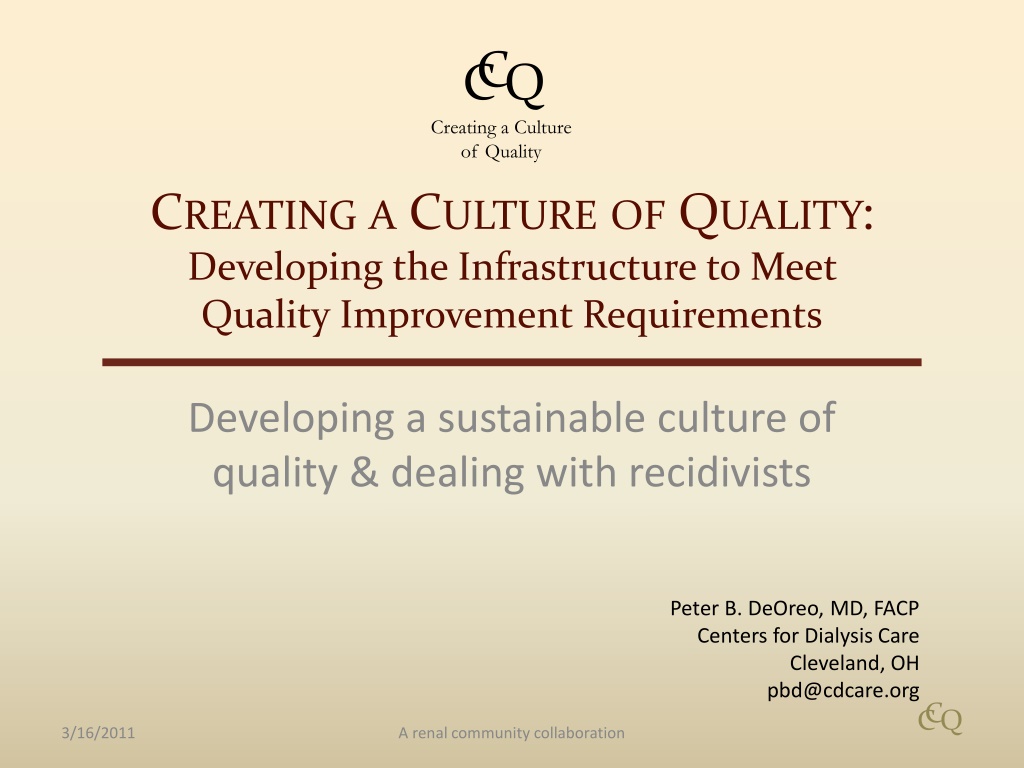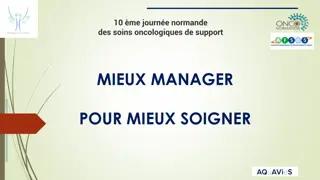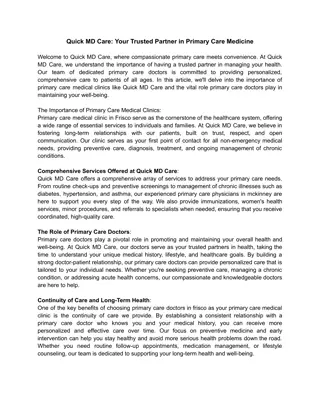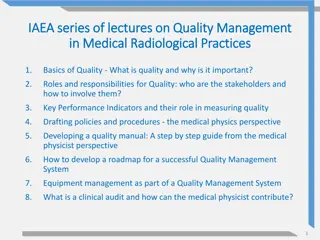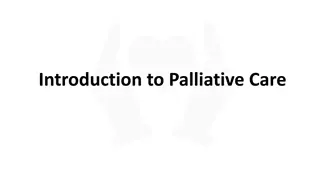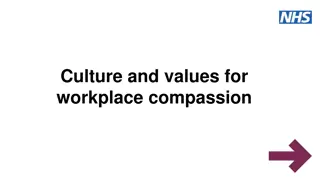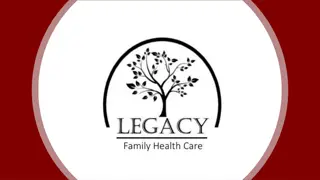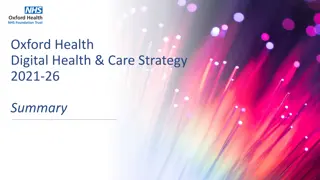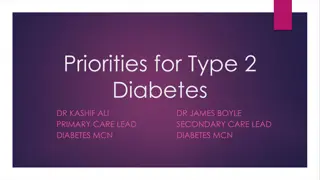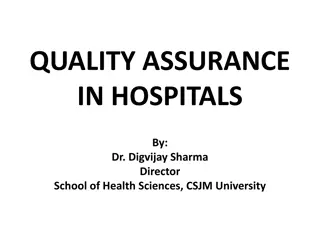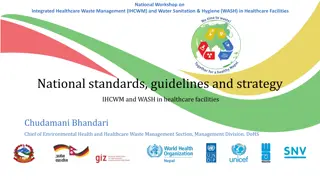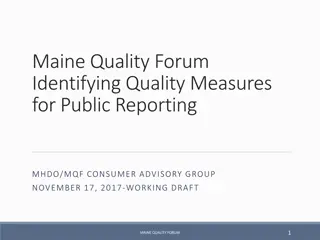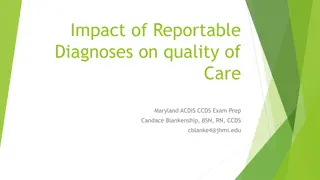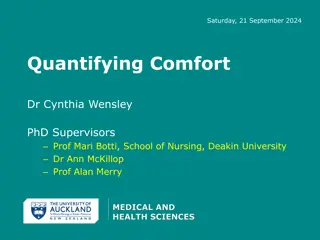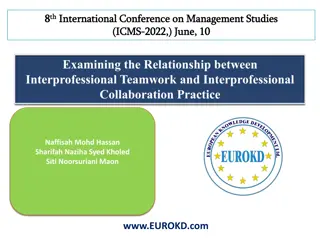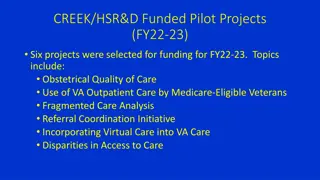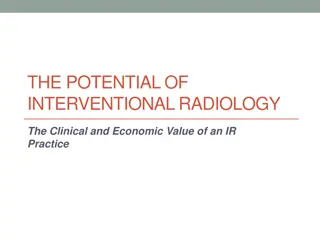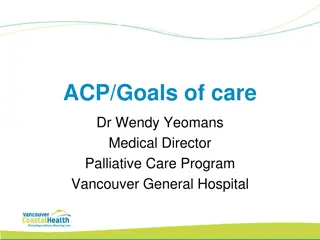Cultivating Quality Care: Strategies for Enhancing Healthcare Outcomes
Focus on developing a culture of quality in healthcare by emphasizing patient-centered care, data-driven improvement cycles, and open communication among care team members. Address common challenges such as the blame trap and the safety/quality conundrum, promoting a shift towards system improvements rather than individual blame.
Download Presentation

Please find below an Image/Link to download the presentation.
The content on the website is provided AS IS for your information and personal use only. It may not be sold, licensed, or shared on other websites without obtaining consent from the author. Download presentation by click this link. If you encounter any issues during the download, it is possible that the publisher has removed the file from their server.
E N D
Presentation Transcript
CCQ Creating a Culture of Quality CREATINGA CULTUREOF QUALITY: Developing the Infrastructure to Meet Quality Improvement Requirements Developing a sustainable culture of quality & dealing with recidivists Peter B. DeOreo, MD, FACP Centers for Dialysis Care Cleveland, OH pbd@cdcare.org CCQ 3/16/2011 A renal community collaboration
Quality Care Quality of care is the degree to which health services for individuals and populations increase the likelihood of desired health outcomes and are consistent with current professional knowledge. Kathleen N.Lohr A Strategy for Quality Assurance Institute of Medicine, 1990 CCQ 3/16/2011 A renal community collaboration
Culture of Quality System of Care that enables Quality Care Keeps the patient at the center of decision making Clear, simple, and consistent P&P Universal accountability toward adherence Leading indicators of critical processes apparent to the owners of the process Data driven improvement cycles Open and respectful communication among and between all levels of the care team CCQ 3/16/2011 A renal community collaboration
Quality Care not Gap between expected and observed outcome What should have happen did not happen Often, Frequently, Usually, Always [pick your choice] Attributed to [blamed on] the mistake, error, or poor performance of an individual CCQ 3/16/2011 A renal community collaboration
The Blame Trap Blame is universal, natural, emotionally satisfying, and legally convenient. It does nothing to make health care safer. -- Reason, 1994 CCQ
Safety/Quality Conundrum Medical workers are expected to function without error. Errors are made by highly competent, careful and conscientious people for the simple reason that everyone makes mistakes every day. Lucian Leape, 1997 CCQ
but the effective remedy is not to browbeat the health care work force by asking them to try harder to give safe care. Poor designs set the workforce up to fail, regardless of how hard they try Crossing the Quality Chasm National Academy Press, 2001 CCQ 3/16/2011 A renal community collaboration
Quality is a system property 1. 2. 3. 4. 5. 6. Safe avoiding injury Effective evidence based Patient Centered respectful and responsive to individual Timely reducing waits and harmful delays Efficient avoids waste Equitable eliminates disparities of care Crossing the Quality Chasm: a new health system for the 21st Century / Committee on Quality Health Care in America, Institute of Medicine National Academy Press, Washington, DC, 2001 National Quality Strategy NQF/National Priority Partnership CCQ
Systems Have a Blunt and a Sharp End acts Patient Care investigation Staffing Supervision Schedules Work Environment Workplace factors Training Equipment Policy and Procedure Organizational Factors Leadership CCQ
Facts about Systems When placed in the same system, people, however different, tend to produce similar results. -- Peter Senge Every system is perfectly designed to get exactly the results it gets. -- Donald Berwick If you do what you always do, you ll get what you ve always got. -- W. Edwards Deming CCQ
Culture is a System Property CCQ 3/16/2011 A renal community collaboration
To Change a Culture Understand elements of human performance Understand what influences behavior Balance no blame with accountability Balance no blame with just workplace Demand open and respectful communication among and between all members of the team Demand visible and effective leadership from the Medical Director CCQ 3/16/2011 A renal community collaboration
To change the culture Change the system Change the reward structure Exploit the factors that influence behavior To change the outcomes of care, change the behavior (process of care) that supports the desired outcome. CCQ 3/16/2011 A renal community collaboration
Human Performance after Rasmussen feed forward Skills Programmed schema routine feed forward Rules If --> Then trained for feed back trial and error Knowledge Synthetic thought CCQ
Assigning Blame (holding accountable) Action intended Reasonable man Drugs involved Knowing violation Prior Acts Outcome intended Good procedure Training or experience Medical condition? Blame correction Blameless No excuse possible sabotage negligent System error reckless James Reason CCQ
How to change behavior If your explanation for all poor performance is the employee is lazy and stupid You assume an unfixable condition. Your interventions are limited. Your success will be limited. You have to explain who hired and trained all these lazy and stupid people. If they weren t lazy and stupid when you hired them, what about working for you makes them lazy and stupid? CCQ 3/16/2011 A renal community collaboration
Changing Behavior Traditional Charisma Power Perks Limitations Not necessary dispositional vs situational Kills relationship (win/loss) Inspires resistance Transient May demotivate Makes satisfaction external Patterson et. al.: Crucial Confrontations McGraw-Hill, New York, 2005 CCQ 3/16/2011 A renal community collaboration
Six Sources of Influence Locus Motivation Ability Pain & Pleasure Undesirable desirable Personal (me) (values) Strength & Weakness Praise & Pressure Help & Hindrance Social (us, others) (culture) Harness Peer Pressure Social Capital Carrots & Sticks Structure Bridges & Barriers (them, things, space) (mission) Design rewards Demand accountability Change the Environment Patterson et. al.: Influencer McGraw-Hill, New York, 2008 CCQ 19
Illustrative Examples Staff Turnover Enhancing RN leadership HD Outcomes Kt/V Dry Weight QAPI process Allergy to Vancomycin CCQ 3/16/2011 A renal community collaboration
Staff Turnover New Hires (RN s and Patient Care Techs) Exit Interview, Surveys, Focus Groups Practice different than P&P and training Emphasis on speed, short cuts encouraged Schedule not followed creating time conflicts Hazing and Intimidation RN s afraid of retribution if hold Techs accountable Patient s inappropriate comments and behavior CCQ 3/16/2011 A renal community collaboration
Locus Ability Motivation go along easier Not able to stand up Not aware that not acceptable Didn t recognize as bullying Personal Peer pressure contrary to P&P Emphasis on Speed Got to suck it up to work here My patient your patient, no our patient Social No consistent accountability to P&P or schedule adherence No zero tolerance on bullying Schedule not efficient No consistent Response to patient intimidation 4 hr pt only 3.5 hr slots Structure CCQ 3/16/2011 A renal community collaboration
Workplace Bullying repeated inappropriate behavior direct or indirect, whether verbal, physical or otherwise, conducted by one or more persons against another or others undermining the individual s right to dignity at work. Task force on the Prevention of Workplace Bullying (2001) CCQ 3/16/2011 A renal community collaboration
Workplace bullying 35% of American Workers have experienced bullying firsthand. 75% of the time, the target of the bullying behavior leaves the company rather than resolves the issue. Turnover attributed to verbal abuse: 24% for staff nurses, 25% for nurse managers. CCQ 3/16/2011 A renal community collaboration
Response Company wide education on bullying Staff do not have to suck it up from their peers or patients Role playing exercises Clear definitions Required Behavior Hold each other to respectful communication Report all incidents Clarify and apply consequences Patients included in the education program Identification of patients with behavior issues care plans (HCTA). Adoption of computerized scheduling Only supervisors can alter or change schedule Patients not allowed to come into treatment area before called CCQ 3/16/2011 A renal community collaboration
Enhancing RN Leadership Multiple Decisions resulted in RN s being out of the treatment area Removal of Med Cart took RN to central nursing station to draw up meds No outside line in treatment area takes RN to central nursing area to page and respond to MD s Computerization of Care Plan forces RN s to compete with Techs for treatment area computers Techs prefer computers on center desk to chairside No need for gloves, Can sit more easily RN absence undermines Nursing credibility CCQ 3/16/2011 A renal community collaboration
Locus Ability Motivation Conflicting expectations Adherence to Med P&P Care Plan completion Personal Detrimental to RN credibility Competition for the work space as the center desk Social Administration slow to respond to RN concerns Task completion more important than professional growth Design of treatment areas did not keep RN visible and engaged in the conduct of the treatment Structure CCQ 3/16/2011 A renal community collaboration
Response Dedicated line red phone for MD~RN communication. Clarification of work area priorities. Training techs to use the height adjustment on computer carts allowing them to sit at the chair-side with the patient New, compliant medication preparation area at center desk. CCQ 3/16/2011 A renal community collaboration
HD Outcomes $ Reward for facility Kt/V achievement Monthly reporting of % pts off at 0.5 KG over dry weight Noted Treatments shortened significantly less frequently on blood day Practice of turning blood flow up 50 ml/min on every one on blood day Blood flow more likely to be at or above prescribed flow on blood day Number of patients with increase in dry weight Number of patients 0.4 KG over dry wt. CCQ 3/16/2011 A renal community collaboration
Locus Ability Motivation Adherence to MD rx not pre- eminent Adequacy not apparent during the treatment Only measured once a month Personal Primacy on moving through the schedule No stigma from inconsistent care Schedule conflicts Social Company rewards outcome not the process (behavior) that supports the outcome Dialysis adequacy measured only 1/13 treatments though technology allows surrogates on every treatment Structure CCQ 3/16/2011 A renal community collaboration
Response In addition to Time Out check list RNTL and PCT shift report Behavior increased communication and collaboration with RN and PCT at the beginning of the treatment Review of Previous treatment Review of today s goals Review of active issues in IDT care plan Identification of issues to be reviewed with MD Behavior increased communication and collaboration with MD and RN MD visit request utility in EMR RN and MD check in at beginning of MD rounds (or round together) Use of On Line Clearance Kt/V Tracking of Kt/V and Dry weight on a per treatment basis Care team QAPI project (QAPI to the chair side) CCQ 3/16/2011 A renal community collaboration
Cumbersome QAPI process Time spent in data aggregation overwhelmed team More time spent in clerical than analytical tasks MD perceived as not involved Delayed and cancelled meetings Distracted by beepers and cell phone CCQ 3/16/2011 A renal community collaboration
Locus Ability Motivation Task tedious, time consuming and meaningless Formal, path of least resistance Personal Most complained about it Shared suffering Not endorsed by Med Dir Social Failure to hold Med Director accountable Failure to integrate data systems Data tables mixed with notes requiring mindless recopying Structure CCQ 3/16/2011 A renal community collaboration
Response Conversation with Medical Director Review 6 sources of influence on his/her behavior Priority Natural Consequences of feckless leadership QAPI meetings scheduled fixed and published Things scheduled around QAPI IT integrated data systems so reports auto- populate and evaluate values, identify trends. CCQ 3/16/2011 A renal community collaboration
Vancomycin Allergy RN reports apparent skin infection in 82 y/o, frail woman with ischemic cardiomyopathy to APN. APN orders Vancomycin over phone, read back confirms. RN records order in EMR. Medication administered per protocol. 15 to 20 min later patient has hypotensive reaction and cardiac arrest. Patient DOA to local EW. Post arrest review, RN notes that Vancomycin allergy recorded in allergy list, dialysis treatment sheet (RN pre-assessment), and med list. RN reports her error to supervisor and risk manager. Investigation shows that Vanco allergy poorly documented, with previous harmless administration. Patient has had hemodynamic instability on HD with profound hypotension. Attending physician concludes medication allergy not causally related to arrest. CCQ 3/16/2011 A renal community collaboration
Locus Ability Motivation Self reported, clearly wanted to do right thing No prior acts slip/lapse Inattention Allergy noted 6 places in record Personal Blaming for error Relied on senior clinician To her detriment Social Na ve about blame/accountability No automatic interaction checking in EMR New EMR Structure CCQ 3/16/2011 A renal community collaboration
Response Step 1 corrective action to RN Mitigated because of self reporting Required to take self study medication safety CEU APN (medical staff) suspended from authority to give medication pending Review of hospital record to document credibility of allergy Required to take self study medication safety CEU Collaboration with EMR provider to add interactions to allergy utility System wide webinar to review the documentation requirements in the EMR System wide review allergy documentation CCQ 3/16/2011 A renal community collaboration
Patients more activated and engaged Physician communication was stronger The IDT was more responsive, involved, and proactive Interpersonal relationships were stronger Dieticians were more resourceful and knowledgeable Coordination and staff management were superior CCQ Customer Service, Accountability, Relationships, Excellence, Safety 39 10/5/2024
Top performing facilities [have a] more staff-oriented and friendly environment marked by better perceived staffing, a more communal and respectful work place, and a stronger emphasis on quality educational programs. This suggests that dialysis managers should aim to formally identify and correct non-adherence with interpersonal and attitudinal best practices . Nissenson, op. cit. p 2030 CCQ 3/16/2011 A renal community collaboration
What did we say (hear) today? There s those that have and those that will. Only badpilots crash, and I m a good pilot There are ALWAYS behaviors that leaders can take to improve their performance and influence Persistence in a low performing status usually points to operational issues beyond content issues Need to state specific desirable behaviors to correct measured deficiencies Nurse Managers need mentoring Sit and Watch CCQ 3/16/2011 A renal community collaboration
And more Why, Why, Why, Why, Why If the manager doesn t feel competent/ confident, what are the patients feeling? The tone is set at the top Focused discipline Explore the backstory Visibility of leadership Culture change it s somebody else s job It has to be safe for people to tell us there are problems Simple recognition can be a powerful motivator CCQ 3/16/2011 A renal community collaboration
And Finally Thank you for a job well done . CCQ 3/16/2011 A renal community collaboration
